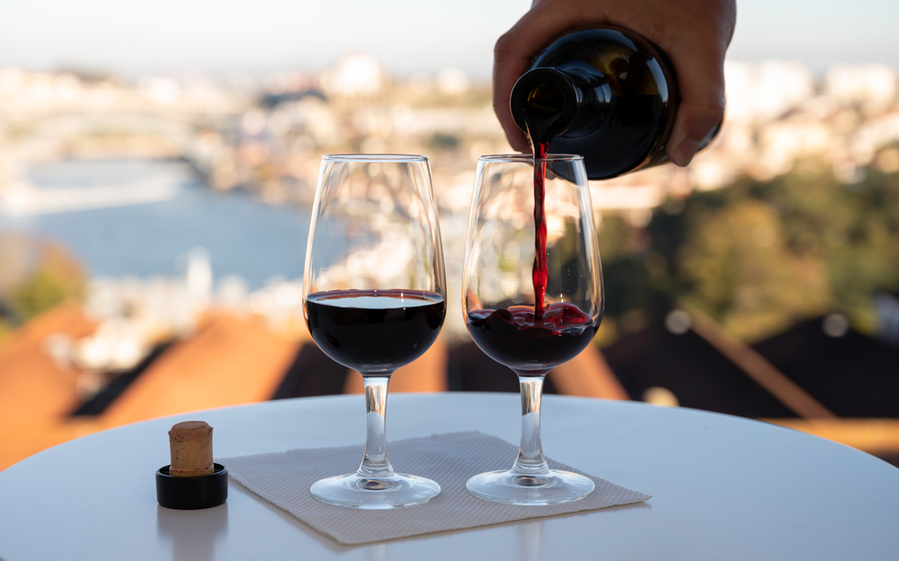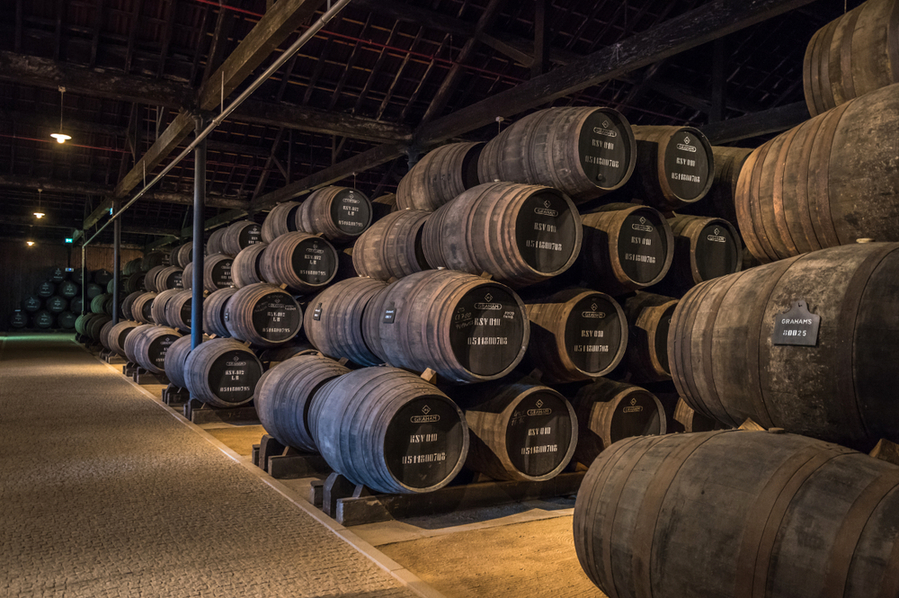
Port is one of the most well-known dessert wines in the world. It is associated with the Douro Valley in Portugal and a protected name like Champagne.
As the story goes, two wine merchants came across an Abbot in a Lamego monastery who added grape spirit to his wine in the early stages to preserve its sweetness.
They copied the idea of ‘fortifying’ their wines to make them last the journey back to England, so Port was introduced to the world.
Tawny Port comes in the basic version, which is briefly aged in wooden casks and then bottled—it may resemble a red wine, but it is much sweeter and more viscous. Then, you get the aged Ports: 10-, 20-, 30-, and 40-year-old Port wines, which develop a vast array of flavors as they are aged.
Being a dessert wine, how do you drink Tawny Port?
Port can be decanted to avoid getting the sediment in your glass or poured carefully to avoid the sediment altogether. Then, kick back and relax while you slowly sip your Port and unwind.
We’ll look at Port ages before we delve into the decanting methods, glassware, and food combinations you can serve with Port.
Port Ages

There are a few variants of the concept of Tawny Ports and aging, ranging from simple to rather dramatic. The basic Tawny Port is followed by 10-, 20-, and 40-year-aged Tawny Ports. The method through which the wine is matured significantly impacts its flavor.
Ruby Port is aged in substantial hardwood casks or stainless steel barrels, keeping the vinosity (wine-ness), rich color, fresh scents, and full-bodied flavor.
Tawny Port is matured in smaller barrels that allow gradual oxidation, affecting the appearance, taste, and fragrance. Tawny Port is ready to drink immediately.
Basic Tawny Port
When poured into a glass, basic Tawny Port is barely translucent and can feature the aromas of roasted nuts, a touch of leather, and slightly dried cherry. It also tastes young wines and lacks the finesse associated with older Port wines.
Ten-Year-Old Port
This follows in the footsteps of a Tawny Port—still garnet-red, but now with pinkish-orange highlights. A ten-year-old Port is a blend of grapes trodden by foot (treading grapes by foot provides the right amount of pressure and body heat). It is then fermented in lagares and aged in small barrels (roughly 650 liters/172 US gallons).
Twenty-Year Old Port
The appearance is much more transparent and paler, resembling faded copper with a bright orange-yellow glow. A lingering butter caramel aftertaste is something to look forward to when sipping a 20-year-old Port.
Forty-Year Old Port
This is the realm of the grand dames of Port, but keep in mind a 40-year-old Tawny Port is a blend of wines with an average of forty years when combined. Some wines might be less than 40 years old, while others are much older. The wine has a brownish tinge, indicating its age.
How To Drink Tawny Port

You can serve Port directly from the bottle or put it in a decanter—any receptacle will do the trick. Tawny Ports are best enjoyed chilled or slightly below room temperature.
The ideal temperature is between 55°F to 58°F (12–14ºC).
Decanting
Ports younger than 40 should be opened and decanted two to three hours before you intend to drink it; if your Port is forty years or older, open and decant it 30 minutes before you intend to serve it.
If you follow the following steps, you are guaranteed to serve and drink Tawny Port correctly.
- Let your bottle stand upright between 10 and 15 minutes if it is younger than 40 years and around 30 minutes if it is older. This allows the sediment to settle at the bottom of the bottle.
- Gently and slowly pour your wine into your selected decanter or jug. Traditionally a candle is placed below the neck to let you see when the sediment is about to make its way into your decanter. A cell phone light or torch standing upright will fulfill the same function.
- Alternatively, pour the wine through a funnel lined with a piece of muslin cloth or an unbleached filter. Bleached filters may give your wine a strange taste.
- You can also serve your Port from the original bottle, but make sure you rinse it thoroughly to remove the sediment and pour your wine back into the bottle.
In the next step, we’ll look at the glassware you should use for serving Port.
Glassware
Port is highly aromatic and is best served in 8–10 oz white wine glasses or a traditional Port glass. Both these glasses allow the wine to be swirled and come into contact with the air, which helps to release its unique flavors and smells.
Make sure your glasses are crystal clean before serving Port because any lingering smells or tastes will affect the taste negatively.
Serving and Drinking Port the Traditional Way
Port is traditionally handed clockwise around the table from the host. There are several explanations for this practice. Because Port is traditionally poured with the right hand, you would be unable to pull a sword or revolver while pouring a glass of Port.
A more practical explanation is that most individuals are right-handed, making pouring with the dominant right hand and passing with the left hand simpler.
The bottle or decanter should not be left down until everyone has filled their glass and the bottle has returned to the host, who will set the bottle down until the next round.
The serving size is about 3 oz, and due to its intense sweetness, it is usually served as a dessert wine.
Food Combinations
Port and stronger cheeses such as Stilton make lovely companions, as do basic or young Port and dark chocolate. Blue cheese brings out the wine’s sweetness without overpowering it.
Smoked, salted, or roasted nuts and Port will go well together because the older Ports, such as ten and twenty-year-old Ports, also have a nutty flavor to them.
Older Port, such as 40-year-old, pairs beautifully with chocolate truffles or Gianduiotti (hazelnut-flavored) chocolates from northern Italy. Gorgonzola cheese and Spanish ham, known as Jamón Ibérico, is another taste sensation that complements the Port.
Of course, you could enjoy your Port on its own.
A mature full-bodied, and fruit-driven Vintage Port is superb with dark chocolate or a slice of strong blue cheese, such as a Stilton.
Older, more elegant, and nuanced Vintage Ports don’t require any additional flavorings and should be appreciated without competing tastes.
Conclusion
When it is young (known as basic Tawny Port), Tawny Port resembles red wine, but because it is fortified, it is much sweeter. As you progress through the years of 10-, 20-, 30-, and 40-year-old Port, the colors and intensity of the flavors develop and intensify.
Ports under forty years old should be allowed to air for around 2 to 3 hours before serving. Still, Ports over 40 years should only air for around 30 minutes before serving.
The best glass is a white wine glass or traditional Port glass because it allows the aromas to be appreciated. The serving size is about 3 ounces.
The most important thing to remember about Tawny Port is to enjoy it and sip it slowly while relaxing and enjoying its unique flavors and aromas.








